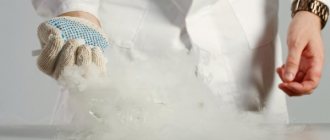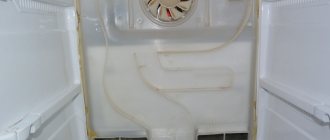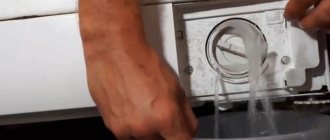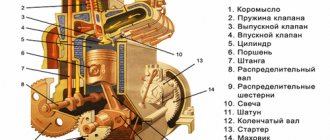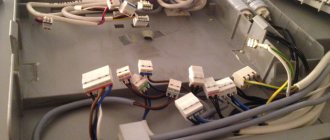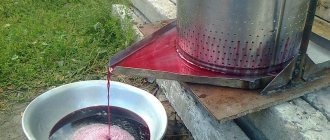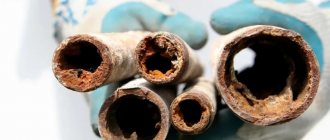If used correctly, a refrigerator is one of the most reliable household appliances, serving its owners for decades. Like all other equipment, the unit requires periodic maintenance and defrosting.
During the next inspection, a situation may arise that you will find a small accumulation of water under food storage containers. In most cases, this phenomenon indicates a clogged condensate drainage system in the device.
Main function of the system
The main purpose of the drainage system, consisting of a technical hole, a drain hose and a receiving tray, is to remove moisture generated during the operation of the refrigerator:
- in household appliances that are equipped with a drip defrosting system, condensation forms on the rear wall of the chamber during operation of the compressor;
- moisture, provided the refrigerator is functioning normally, flows down a special groove into the drainage hole;
- a plastic tube is attached to the hole, through which the liquid flows into a reservoir located on the compressor;
- The electric motor heats up during operation, due to which condensate evaporates from the tray into the surrounding atmosphere.
IMPORTANT! The serviceability and normal functioning of the drainage hole facilitates the smooth removal of moisture from the refrigerating chamber, as a result of which condensation does not accumulate inside the refrigerator and does not flood the electric motor.
Do you regularly clean your refrigerator drain?
Not really
Where is?
The water drainage hole is located at the bottom of the rear wall of the refrigerator compartment.
In devices equipped with a know frost system, the drainage system is located behind a special panel on the rear wall , therefore, in order to perform a preventive inspection of the device element or clean it, the protective panel must be removed.
Find out right now: how to defrost a Bosch refrigerator. Step-by-step instructions for defrosting an Indesit refrigerator are presented here.
How it works
Modern refrigerators relieve their owner from the need to defrost themselves regularly, every week. This should be done extremely rarely, once every 6 months, 12 or a couple of years. This pleasant option is provided by the drainage-evaporation system. In refrigerators with a condensation circuit, where there is a moisture collection panel on the back wall inside the chambers, it works like this:
- when the compressor operates, the panel cools intensively;
- the air in the chamber cools down, the steam it contains condenses on the panel;
- water flows into the lower gutter;
- through the drain tube, moisture from the chambers is discharged into the pan on the compressor engine;
- heating up during operation, the compressor evaporates moisture into the air in the room.
Refrigerator drainage system
If the drainage system is functioning properly, it does not require intervention. But when its main part, the discharge tube, becomes clogged, various unpleasant consequences arise. And water in the lower zone of the refrigerator is one of the most harmless.
If there is insufficient moisture removal, a thick layer of ice can form on the walls of the chambers, which leads to a decrease in the efficiency of the refrigerator and overload of the compressor.
In models with the NoFrost system, everything works according to the above algorithm with one exception. All parts of the drainage system are hidden from view and are located behind a panel on the back wall of the refrigerator. To access the tube and clean other elements, it will have to be removed.
Why is it clogged?
A decrease in moisture permeability or complete blockage of the hole can occur for the following reasons:
- food (particles of greenery, crumbs) getting into the tube leading to the drainage system, or directly into the hole itself;
- lack of regular maintenance and washing of the internal surfaces of the electrical appliance;
- placement of products close to the back wall: as a result of the temperature difference, food particles freeze to the surface, after which, as condensation drains, they fall into the drain hole;
- improper installation of the refrigerator (the device is standing on an uneven surface): in this case, the seal of the chamber door is broken and warm air gets inside the device. The compressor works in increased mode to compensate for the lack of cold, the refrigerator turns off less often. If defrosting cycles become slower, the drainage system will not be able to cope with the increased amount of condensate.
How do you know when it's time to clean?
The need to carry out a procedure to remove blockages in the drainage is indicated by the formation of puddles of water at the bottom of the refrigerator compartment, under the drawers for storing vegetables and fruits.
Signs of a blockage
If, after removing the moisture, you notice that soon water has again flowed into the lower part of the unit or ice has appeared around the condensate drainage hole, the system urgently needs to be cleaned.
IMPORTANT! The accumulation of excess moisture in the unit chamber can be a consequence not only of blockage, but also of damage to the drainage tube or hole. Therefore, in addition to cleaning the system, be sure to inspect these elements and, if necessary, replace them.
Ways to Clean a Drain Tube
Removing the blockage, in most cases, can be done independently, without the involvement of specialists.
The system is cleaned mechanically:
- To remove obstacles that interfere with the normal passage of moisture, start by cleaning the hole with a small brush, a brush (you can use an old toothbrush) or cotton swabs;
- if the manipulations did not help restore the drainage, try using the cleaning method using a medical syringe or rubber bulb;
- If the system is significantly clogged, use the wire cleaning method. In this case, the device will have to be defrosted and left to dry for 8-10 hours.
IMPORTANT! When using the water rinsing or wire cleaning method, be sure to unplug the refrigerator and remove the drawers from it.
Children's syringe-bulb and ear stick
First, use a foam sponge to remove any accumulated moisture from the bottom of the refrigerator and around the drainage hole. Then take a few cotton swabs or a small brush (a special brush designed for cleaning refrigerator drains) and follow these steps :
- carefully place the stick in the hole and, turning it with your fingers, move it slightly inside the channel;
- slowly remove the tool from the hole, inspect the cotton: if the material is dirty, repeat the procedure several more times.
To disinfect the drain channel, make a soda or vinegar solution, soak a stick or brush in it, or treat the clean hole again.
ATTENTION! After completing the procedure, be sure to check the operation of the drainage: fill a small rubber bulb (a baby syringe with a soft tip) with warm water and use it to inject the liquid into the drain. If the water flows freely into the tank, the blockage has been removed.
Syringe or rubber bulb
Strong water pressure can easily wash away food particles that have entered the drain. To implement this method of cleaning the system, purchase a rubber bulb for douching at any pharmacy.
A large-volume medical syringe (20-50 ml) is also suitable:
- slightly heat the water, fill the instrument with warm liquid;
- insert the tip of a bulb or syringe (no need to install a needle) into the hole and sharply squeeze the walls of the rubber device (if you are using a syringe, press firmly on the piston);
- repeat the procedure 4-5 times.
ADVICE! To wash the drainage, you can use a soap or soda solution, or special disinfectant chemicals.
Wire
If it was not possible to clean the system with water and cotton swabs, use the following method:
- defrost the refrigerator (defrosting time is at least 8 hours), remove the water around the drain hole with a sponge, rinse it with water pressure using a medical bulb;
- cut a small piece of soft, preferably copper wire (or wire) of such a diameter that it can freely pass into the drainage channel;
- bend one end of the wire into a loop, place it in the drain hole;
- Using back and forth movements, push the dirt towards the liquid collection tank;
- After the procedure, fill a rubber bulb or syringe with warm water and rinse the canal again.
You can clean the drainage system with wire not only from the inside of the refrigerator compartment, but also from the outside - from the outside of the household appliance.
IMPORTANT! Be extremely careful and do not make sudden movements during the procedure so as not to damage the drain tube or plastic parts of the unit.
How to Clean the Drain Hole in a Refrigerator
A refrigerator is a piece of equipment that requires maintenance. But often we don’t attach much importance to this. And such negligence can lead to its breakdown, for which you will have to pay a considerable part of your hard earned money. But with proper attention and care, your great friend in the kitchen can serve faithfully for many years. Have you often noticed the accumulation of water in the refrigerator? It would seem that there is nothing wrong. But no. Water shouldn't pool, most likely your drain hole is clogged and needs to be cleaned. Over time, it becomes clogged with mucus and small food crumbs, which causes an unpleasant odor in the refrigerator and the water does not drain away. Ice forms, which leads to a decrease in power. Therefore, it is recommended to clean it periodically. Let's figure out how to do this.
Methods for cleaning the drain hole
The drain hole is a plastic tube on the back of the refrigerator that leads to a plastic tray near the motor. There are different ways to clear it, depending on the severity of the blockage.
- You can clean the drain hole with a special brush, which you can buy at a plumbing store. You can also use a cotton swab instead of a brush.
- This can also be done using a regular medical syringe or rubber bulb. You need to take warm water and forcefully inject it into the tube; accordingly, this is done after defrosting the refrigerator. The described action must be performed several times, and the water can be diluted with detergent.
- For the third cleaning method, you need to defrost the refrigerator and leave it to dry for 6-10 hours. After this, prepare a long thin wire and push the remaining food through it. But be careful: under no circumstances should you damage the tube. You need to clean the drain from both sides. Next, you need to rinse the hole with warm water. You can also clean the hole by removing the drain pipe, this way you will achieve a better result.
All of these methods are applicable to cleaning the drain in the refrigerator compartment, but the drainage compartment in the freezer also needs the procedure. It is strongly not recommended to clean the latter yourself, since it is deep and there is a possibility of damaging the mechanisms. In this case, you should contact professionals.
The problem lies in the reason
It is important to understand that the cause of water in the refrigerator may not only be a clog. Damage to the drain tube or hole is a common occurrence, after which water accumulates on the bottom shelf of the refrigerator or even under it
To solve this problem, it is necessary to inspect the pipe and fix it in the required position. If there is actual damage to it, it is better to install a new one.
Another reason could be that the refrigerator is not level, causing the doors to not close tightly and allowing heat to enter. The compressor tries to restore the optimal temperature and begins to freeze more strongly, which causes frost to appear on the walls. And the latter melts, forming water in the refrigerator. Solving this problem is not difficult; you just need to adjust the level of the refrigerator.
The cause of the problem may also be damage to the tank into which the liquid is drained from the drain hole. In this case, it needs to be replaced. You shouldn’t do this yourself, as finding a suitable spare part for a specific refrigerator model can be difficult. Entrust this matter to professionals; the costs of such repairs are usually not too high.
Conclusion
To summarize, we can say that you can fix some problems that arise while using the refrigerator yourself, but to solve others you will have to seek the help of specialists. But the main thing is that you must always monitor the condition of your equipment, follow the operating rules, and then it will serve you for a very long time.
The use of special chemicals to kill bacteria
In addition to the forced cleaning of the drainage hole from blockages, it is advisable to wash and disinfect this functional unit of the refrigerator regularly - at least once every six months .
This part of a household appliance is constantly in contact with moisture, which is a favorable environment for the life of many microorganisms, including pathogens.
To eliminate bacteria, chemical preparations are suitable, the composition and method of application of which is presented in the table:
| Name of the drug | Compound | Mode of application |
| Dezavid | polyhexamethylene guanidine hydrochloride 9%, alkyldimethylbenzylammonium chloride 1%, functional components purified water | Pour the product into a rubber bulb or syringe and fill the channel, plugging the drain tube from the outside. After 5-7 minutes, rinse the system with clean water. |
| Kenolux Eco Dez | quaternary ammonium compounds, nonionic surfactants | Fill the drainage channel with the product (using a syringe or medical device for douching), after 10 minutes, rinse the system with water |
| Hydrogen peroxide (3%) | Hydrogen peroxide, sodium benzoate, purified water | Shut off the water outlet from the outside of the drain hose, pour the product into the drainage hole, after 10-15 minutes remove the plug from the tube, let the liquid drain out. Rinsing with clean water is not necessary. |
REFERENCE! To remove the blockage, you can use chemicals containing chlorine, but after the procedure, the channel should be thoroughly rinsed and the refrigerator should be left for a while with the door open so that the pungent odor of the product disappears.
Use of disinfectants
To disinfect the drain tube, the use of antiseptics is required, since the food storage chamber is directly connected to the condensate collection system. Mold, fungi, and bacteria can accumulate in the tube. After cleaning, it is possible to close the drainage hole in the refrigerator in front of the condenser. The disinfectant solution can be left for 5-7 minutes.
After settling, the tube is washed several times to remove the disinfectant. There are various types of disinfectants based on chlorine and hydrogen peroxide. Depending on the activity of the disinfectant, the exposure time may vary; before use, you should read the instructions.
Dehumidification system for nofrost devices
What happens if you don't clean it?
Deterioration in the quality of the condensate drainage system from the chamber leads to serious consequences:
- a persistent, unpleasant odor appears in the inside of the refrigerator, which is impossible to get rid of even with the help of special flavoring agents;
- in a humid environment, various bacteria and mold develop, as a result of which it becomes unsafe to store food in a household appliance;
- The gradual accumulation of moisture at the bottom of an electrical device leads to water penetrating through the outer parts of the device body to its metal elements, which, in turn, can cause rusting.
In particularly advanced cases, lack of maintenance of the refrigerator drainage system can cause a short circuit.
IMPORTANT! The plastic reservoir for collecting liquid also needs periodic cleaning, since it often becomes dirty as a result of food particles, dust, and grease passing through the drain system.
How to clean appliances with No Frost?
In modern kitchen appliances equipped with a no-frost defrosting system, a dirty drainage hole contributes to the formation of a layer of snow and ice at the bottom of the freezer .
With increasing load on the compressor of the device, the performance of the refrigerator noticeably decreases. As a result of prolonged operation of the motor in heavy duty mode, the equipment may fail.
Since the drain hole in refrigerators of this type is located behind the protective panel, cleaning it is a very complex process and associated with the risk of incorrect dismantling and installation of appliance parts.
Therefore, if the drainage system of a unit with a no-frost system is clogged, it is advisable not to act on your own, but to seek help from a service center and call a technician to your home.
REFERENCE! In many cases, deterioration in condensate drainage is due to freezing of water in the drainage hose. To fix the problem, turn off the power to the device for 48 hours: the frozen moisture in the tube will thaw and condensation will flow through unhindered.
If you are interested in how and what to use to remove dents on the surface of a refrigerator, read this article.
How to clean drainage in NoFrost refrigerators
On NoFrost models, the drainage is located behind the rear panel on the refrigerator body. To clean such a system, it is recommended to contact a service center. You should only do this yourself if you are completely confident in your skills.
The first sign of clogged drainage in refrigerators of this class is a large layer of ice at the bottom of the freezer. This causes reduced cooling efficiency and increased compressor loads.
You should call a professional to clean the drainage in your NoFrost refrigerator.
It often happens that moisture removal is disrupted due to freezing of the tube and areas of the condensate collector. Therefore, before calling a technician, it is recommended to defrost and completely de-energize the device for at least 2 days.
Useful tips
To prevent an increase in humidity in the refrigerator and reduce the number of times you clean the refrigerator drainage system, adhere to the following rules when operating the household appliance:
- regularly carry out the procedure for washing internal surfaces, which will prevent the accumulation of debris in the chambers;
- place products on the shelves of the unit at a short distance from the walls of the compartments so that packaging material and products do not touch them and do not freeze;
- periodically inspect the drainage hole and clean it, if necessary, with cotton swabs, a brush, or the pressure of warm water using a rubber bulb.
The problem of clogging of the hole and condensate drain tube is not a serious breakdown, but rather relates to the maintenance procedure of the device.
If during operation of the refrigerator you begin to notice small accumulations of water on its bottom, immediately begin cleaning the drainage system.
Was this article helpful to you?
Not really
Video: DIY drainage hole cleaning
- 20.1. Related articles:
Cleaning the drainage hole yourself
Watch this video on YouTube

